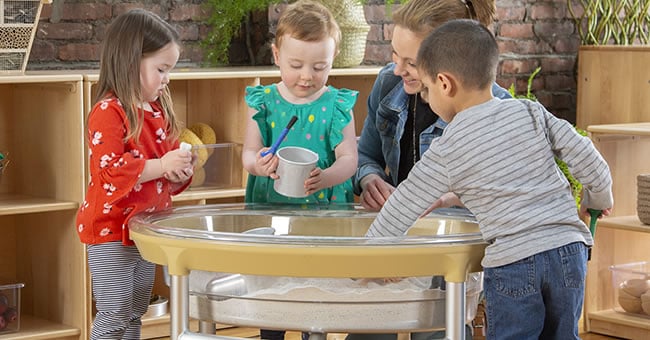
Sand and water tables are fun and entertaining and provide many sensory and educational experiences for children, but they can also be a breeding ground for germs and diseases if you don't clean them properly. We've come up with a great list of tips and tricks to utilize the next time you need to clean your sand and water table!
Cleaning Your Sand and Water Table
According to the National Resource Center for Health and Safety in Child Care and Early Education, you should follow these guidelines when cleaning your sand and water table:
- Sand should regularly be cleaned of foreign matter and should be replaced as often as needed. Your goal should be to keep the sand visibly clean and to ensure that it's free of extraneous materials. Try using colanders and sand rakes to clean and sift through the sand in your table.
- Fill your sand and water table with fresh potable water immediately before children begin playing at the table. Be sure to change the water each time a new group begins a water play activity. Free-flowing potable water can be used if there is a suitable inlet and outlet of water.
- The water basin(s) of your sand and water table and any sand and water toys should be washed and sanitized at the end of the day. Make sure to wash and sanitize the basin(s) and toys prior to use if they have been used by children in another classroom.
- Wash, rinse, and wipe your sand and water table or other work surfaces with a solution of two teaspoons of bleach to one gallon of water. Let the solution sit for at least two minutes before draining and letting the table air dry. Remember to check your state guidelines to see if they have any specific policies about cleaning sand and water tables or what type of solution/cleaner to use.
Keeping Your Sand and Water Table Clean
- Put a cover on your sand and water table when it's not in use to help keep it from getting dirty. If your sand and water table didn't come with a cover, try using plastic or cardboard as a cover.
- Sift the sand around at least once a week. This helps ensure that the sand on the bottom is moved to the top, and it also helps aerate the sand.
- Ask children to wash their hands before and after they use the sand and water table. If children have cuts, scratches, or sores on their hands, don't let them use the sand and water table until their hands are healed. This will help prevent germs from spreading.
- Use prepackaged sterilized sand in your sand and water table to ensure the sand is free of toxic or harmful materials. You can sanitize most of the sand you use in your table by picking out any debris, spreading the sand out, misting it with sanitizer, and allowing it to air dry. You can also use alternative materials, such as Colorful Kidfetti, if you don't want to use sand or your state doesn't allow it.
